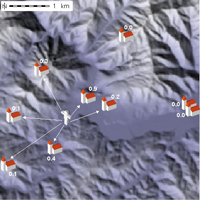A soundscape is an acoustic space relative to the listener, his/her interpretation of acoustic space.
A digital model of a soundscape is therefore a fuzzy acoustic space from the perspective of the listener situated in the map and is represented as a set of fuzzy audibility levels from each sound source.
The model can be understood as a set of affordances that surround the listener and offer him/her an opportunity to act. I believe this model of a soundscape is close to Gibson's idea of direct perception as it is not a result of computational activity of an agent, but sets him/her in an ambient array, acoustic space in this case, and allows him/her to recognise affordances.

Figure 6: A digital soundscape model
However, as affordances can only be recognised in the context of practical action and are relationally specific to individuals, it is therefore extremely important to know what or who the agent is. Gender, habitus, life history, social networks, handicaps and desires of an agent in a taskscape and his/her relationship to other agents creating their own taskscapes set the context for his/her actions. Therefore interpretation of past soundscapes can only be contextual. Technology, in this case GIS, can assist us in the re-creation of past acoustic spaces, but clearer and better models of past soundscapes can only be created when our understanding of past social life gets richer or 'thicker'.
© Internet Archaeology
URL: http://intarch.ac.uk/journal/issue16/6/44.html
Last updated: Thur Nov 11 2004